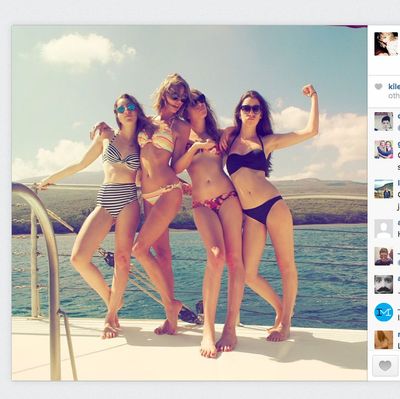
This week the Cut explores the messy, loving, spiteful, supportive, competitive, joyful, and funny sides of friendship.
Recently, an acquaintance I’ll call Tory started posting daily Instagram photos of her new boyfriend. Shirtless, he leaned toward the camera. Bedheaded, he reclined on a pillow. Snuggling, they appeared in a photo format that I have since been informed is not a selfie, but an ussie. Though I’m not close with Tory, I knew her well enough to become, almost instantly, invested in the relationship. I talked about them like characters in a telenovela — did they seem right for each other? (Yes, that kind of ussie chemistry cannot be faked.) Were they moving too fast? (No, this is the velocity of love.) What — oh my God — Anne, didn’t you used to date this guy?!
There, in the middle of the soap opera I’d projected onto two people I barely knew, was someone I did know, a man my friend Anne used to date. He was arm-in-arm with Tory’s boyfriend. Suddenly, the nature of my engagement changed. Whereas previously I’d only been active in my imagination (I hadn’t tracked down names or identified accomplices), now I was embarking on a full-on cyberinvestigation. Why did Tory know Anne’s ex? Was he friends with Tory’s new boyfriend? Wait, Tory’s boyfriend knows a guy I once texted with! Is he the one who introduced them all? Oh, wow, looks like they’re regulars at that bar. As I scrolled down to check who was tagged in which photographs — and who was liking them and who was commenting — I fell into a pattern that one friend described as clique-stalking. That is: the sick pleasure of noticing, then picking apart, social-media interactions to determine which of your acquaintances know each other, and how, and why, and to what degree. It’s an impulse most of us left behind in the high-school cafeteria, but by the power vested in the “Activity” tab in Instagram — and Twitter’s “Discover” tab and Facebook’s “Ticker” column — clique-stalking is back.
Clique-stalking happens when you fall down the rabbit hole of clicking the names tagged in distant friends’ photos, then cross-checking for other mutual friends; when you Google a stranger because you always see her commenting on your ex-boyfriend’s friends’ Instagrams; when you see a Twitter handle you don’t recognize in an @-reply, then check who else he’s been talking to. You’re figuring out other people’s social worlds, and how and if they connect to yours. Sometimes you have a motive. (Should you befriend this person?) Sometimes you’re simply curious.
Due to its proximity to FOMO and ex texts, clique-stalking tends to get a bad rep. “I remember the day I realized that my co-worker was at party that my ex-boyfriend’s band played at,” my friend Rita said through a face-palm, “and I was like, ‘Why are you even at the same party? Is everyone hanging out?’” (She and several others requested pseudonyms, but don’t let that stop you from clique-stalking your way to their true identities.) Like most forms of social-media stalking, clique-stalking tends to leave its perpetrators feeling a little dirty — like a Peeping Tom, perhaps, or a couch potato.
But clique-stalking can be joyous, too. There’s the pleasure of realizing that two friends you thought were separate are, in fact, available for hanging out together. (A realization that grows more valuable with age, as free time grows more scarce.) And there’s the excitement of realizing that someone you once found mildly interesting now interests you greatly due to social or romantic intrigue. (Think of the moment when Britney Spears became BFFs with Paris Hilton.) And there’s the discovery of someone new to fascinate you. (“Can I meet that girl you keep Instagramming?” an acquaintance once asked.) And there’s the simple pleasure of the unexpected: “So many words colliding,” one of my college besties commented on an Instagram photo of me posing with one of his current besties. (Did you follow that? After growing up and moving apart, we unknowingly befriended friends.) And even if the actors themselves are relatively inconsequential, still I find that simple act of connecting the dots strangely satisfying — akin, perhaps, to the satisfaction felt by the first explorers to successfully circumnavigate the world.
Clique-stalking can occur at any level of friendship or distance. When I asked people for their favorite clique-stalking subjects, Taylor Swift’s friends came up frequently. Rihanna’s heavily tagged Instagram crew is another source of fascination. The entourages of rappers and hip-hop moguls are the stuff of legend. Part of the joy of social media is the blurring of boundaries between celebrity and civilian — Rihanna’s non-famous friends appear to be famous, while Rihanna appears like she could be my friend. And people like Tory can be my Rihanna, turning my Instagram feed into a gossip page loaded with intrigue.
But how accurate is the knowledge gleaned from clique-stalking? Are my cyberinvestigation techniques the stuff of Woodward and Bernstein, or The National Enquirer? To find out, I called Tory.
Like a true celebrity, Tory declined to discuss her personal life in detail. She did agree, however, to fact-check the deductions I’d made about her new boyfriend and clique: “No matter when you start dating, it’s when you start putting pictures on your Instagram that you get so many questions: Who is this guy, how did you meet him, that kind of thing. But I’m also not surprised because I know I left breadcrumbs on my own.” Based on the people who’d made inquiries, Tory had deduced that my friend Anne was somehow at the center of the investigation — she’d reverse-clique-stalked our clique-stalk, if you will, and she admitted that she understood my impulse. She met her new boyfriend after interacting with him on Twitter — before agreeing to a date, she’d checked their mutual follows and friends.
Unfortunately, she says that my detective work was fairly shoddy. Turns out the picture that started my clique-stalk — depicting Tory’s boyfriend arm-in-arm with Anne’s ex — was a fluke. “We’d just met him that day at a party,” Tory said. There was no clique.
For a moment, I sat in stunned silence. So there wasn’t an elaborate network of distant acquaintances partying just out of my reach? It was like she’d taken my Barbie Dreamhouse away. What was I supposed to project my social imagination onto now? Returning to Instagram, I clicked through to the profile of a man I used to date, and noticed a chubby bulldog in several pictures. Whose dog is that? Did he get a new roommate? I don’t recognize the park they keep taking this dog to, but maybe I can triangulate its location somehow? Who is this woman who keeps saying “Awww” — does she know the dog? And so it began, again.




